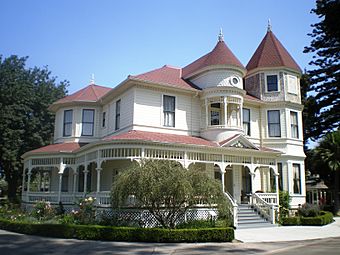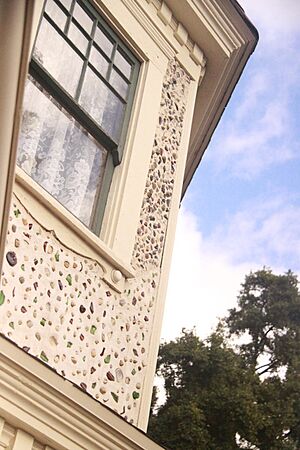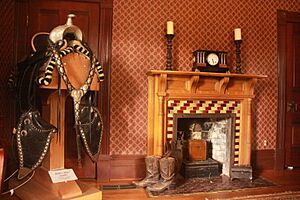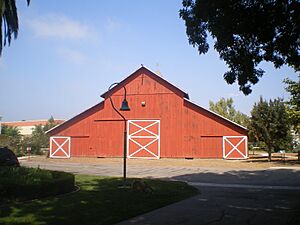Camarillo Ranch House facts for kids
Quick facts for kids |
|
|
Camarillo Ranch House
|
|

Camarillo Ranch House
|
|
| Location | 201 Camarillo Ranch Rd., Camarillo, California |
|---|---|
| Built | 1892 |
| Architect | Herman Anlauf, Franklin Ward (original) Lopez Architects, Craig J. Lopez (restoration) |
| Architectural style | Queen Anne |
| Restored | 1998 |
| NRHP reference No. | 03000039 |
| Added to NRHP | February 20, 2003 |
The Camarillo Ranch House is a beautiful old home in Camarillo, California. It is also known as Rancho Calleguas or the Adolfo Camarillo House. This large house was built in 1892 and is designed in the Queen Anne style, which was popular during the Victorian era.
The house is about 6,000 square feet (557 square meters) in size. It was designed by architects Herman Anlauf and Franklin Ward. Adolfo Camarillo managed the ranch for 78 years. He changed the ranch from mostly raising cattle to growing many different crops. Adolfo was a very creative farmer. He grew lima beans, barley, corn, alfalfa, walnuts, and citrus and eucalyptus trees. The Camarillo Ranch House became a special historic place in 2003. It was added to the National Register of Historic Places.
Contents
History of the Camarillo Ranch
The story of the Camarillo Ranch begins with Juan Camarillo. He came to California in 1834 as part of an expedition. Juan and Martina Camarillo got married in 1840. They moved to Ventura, California in 1854. They were one of the first European families to settle there.
In 1876, Juan Camarillo (1812–1880) bought a huge piece of land. It was called Rancho Calleguas and was about 10,000 acres (40 square kilometers). He bought it from Jose Pedro Ruiz for $3,000 in gold. This was a lot of money back then!
Adolfo Camarillo: The Ranch's Innovator
Juan Camarillo passed away in 1880. His oldest son, Adolfo Camarillo (1864–1958), took over the ranch when he was just sixteen years old. Adolfo worked hard and turned the ranch into one of the biggest bean farms in the world.
Adolfo Camarillo hired 700 workers for his ranch. He grew so many beans that he could even help set the price for beans in the market. The main Ranch House was built in 1892 under Adolfo's guidance. He used architects Franklin Ward and Herman Anlauf for the design.
Adolfo was a proud man of Spanish heritage. He would have preferred a Spanish-style home. However, many homes nearby were owned by people from Eastern Europe. Adolfo was highly respected in his community, even though he was only 4 feet 11 inches tall. He was often seen riding his beautiful purebred white stallions.
Adolfo's wife, Isabella, wanted to fit into their new community. She would invite guests for tea, jam, and tortillas. She enjoyed English culture but also brought her own traditions into it. Adolfo always had fresh tortillas for breakfast. The Camarillo family had many servants who lived and worked on the ranch. A long hallway, called a breezeway, separated the family's living areas from the servants' quarters.
Adolfo Camarillo became one of the richest landowners in the county. In 1911, he was chosen to lead the Ventura County Board of Supervisors. He also served on the State Board of Agriculture. For 78 years, Adolfo managed the Camarillo Ranch. He changed it from a cattle ranch to a place that grew many different crops. He was a leader in farming, growing lima beans, barley, corn, alfalfa, walnuts, citrus, and eucalyptus trees. People sometimes called Adolfo "The Last Spanish Don." He was a community leader and gave a lot of money to help shape the City of Camarillo.
The Ranch Changes Hands
In 1963, the Camarillo family decided to sell most of their large ranch property. The land was eventually sold and turned into neighborhoods, shops, and businesses. The Camarillo family kept about 100 acres (0.4 square kilometers) of land, which included the old ranch house.
Architecture and Life at the Ranch House
After getting the ranch from his mother in 1891, Adolfo Camarillo hired architects Herman Anlauf and Franklin Ward. They built the 6,000-square-foot (557-square-meter) Queen Anne style Victorian house in 1892. These architects also designed another famous house nearby.
The Camarillo Ranch House has two round towers, a large porch, and big, open lawns. Adolfo also planted many different kinds of trees around the house, including eucalyptus trees. For the next 70 years, the Camarillo Ranch House was the main center of the huge Rancho Calleguas. From this house, Adolfo managed the ranch's production of lima beans, walnuts, and citrus fruits. The house also became famous for the fun barbecues, rodeos, and fiestas that Adolfo hosted. Adolfo lived in this three-story, Victorian mansion until just before he passed away in December 1958.
Even though the Camarillo Ranch House was in sunny Southern California, it was hard to keep warm in the early 1900s. Almost every room in the house has a fireplace. Adolfo was always looking for new technology to help with ranch problems. He was the first farmer to buy a refrigerator. Back then, a refrigerator was so big it took up an entire room! But it meant he could safely store food that would spoil quickly. He also had many heaters put in the house to keep his family warmer.
The most beautiful room in the house belonged to Adolfo's middle daughter, Carmen. Carmen loved horses. She learned how to care for them from the Ranch Manager, Meliton Ortiz. Meliton Ortiz would visit the ranch house often, even until he passed away in 2010. He shared many stories about growing up on the ranch.
The home was updated in 1914 when Carmen, the oldest daughter, got married. They opened up many rooms by taking down walls and changing the design of the stairs. The grand parlor, a large living room, changed the most. It went from several smaller rooms to one huge open space. This was done to make the house feel more open and spacious.
In 1998, a company called Lopez Architects helped restore the house. They made sure the house was safe from earthquakes. They also made it look like its original design, including the rooms, outside porch, and Victorian style. Between 1999 and 2000, the City of Camarillo and the Camarillo Ranch Foundation worked together. They spent $1.5 million to restore the house, barn, and stables. The restoration was finished in 2001. Now, the three-story, fourteen-room Queen Anne Victorian home is a museum. It offers tours and hosts many events.
Camarillo White Arabian Stallions
The Camarillo Ranch is famous for the beautiful white Arabian parade stallions that Adolfo bred. He would ride them in the yearly Fiesta of Santa Barbara. He wore colorful Spanish clothes for these parades. Adolfo's first special horse was named Sultan. Sultan was a pure white horse, part Arabian and part Morgan. It was said that Sultan would have "snow white, pink skinned foals" no matter what color the mother horses were.
Since the 1920s, the Camarillo horses have appeared in many parades. They were even at the opening of the San Francisco-Oakland Bay Bridge in 1941. In 1950, the Camarillo horses led the famous Rose Parade. They have been in many Rose Parades since then. Even after Adolfo passed away in 1958, his family continued to breed the white Arabians. They kept riding them in local parades. In 1967, the family still had about a dozen Camarillo white Arabians. The Los Angeles Times wrote a story about them. The newspaper said, "The Camarillo horses love a parade. Any spectator who has ever watched one dance down the street -- a brightly costumed member of the Camarillo family astride a heavily ornamented silver saddle -- can attest to the predilection."
The Ranch House Today: A Community Treasure
In 1998, the city allowed an industrial park to be built around the Camarillo Ranch House. But there was a condition: the developer had to give the ranch house, barn, and 4.4 acres (1.8 hectares) of land to the city. The city then fixed up the house and opened it to the public in 2001. It is now a museum and a place for parties and other events.
The house is managed by a group called the Camarillo Ranch Foundation. This group is a non-profit, which means they don't make money from their work. The renovation cost $1.5 million. Many volunteers also helped, giving 10,000 hours of their time to the project.
The Camarillo Ranch House is a popular spot for weddings and parties. It is also used for filming movies and TV shows. One person who finds locations for films said the house looks like a rural setting "almost anywhere in the United States."
Events and Activities at the Ranch
The Camarillo Ranch Foundation runs the house. You can take tours led by guides on Saturdays and Sundays. The house can also be rented for weddings and other special events. The Foundation holds yearly community events. These events teach people about Camarillo's history. They host over 150 private and public events every year.
The Camarillo Ranch House is a popular wedding place. It has four different areas for events: the Front Lawn, the Red Barn, the East Garden, and the West Garden. Around the property, there are several themed gardens. These include a butterfly garden and a formal Victorian garden. The Ranch House also hosts events for businesses and non-profit groups.
About the Camarillo Ranch Foundation
The Camarillo Ranch Foundation was started in 1998 by the City of Camarillo. It is a non-profit group that helps the public. A board of 15 directors manages the Foundation.
The Foundation's goal is to:
- Keep, fix, run, and take care of the Camarillo Ranch as a historic site.
- Work with public and private groups to make it self-supporting.
- Help it keep its place in California's rich history.
- Make it a main gathering place for the community.
- Offer education, fun, and enjoyment.
- Show off our diverse history and culture.
The Camarillo Ranch House offers programs that help the community. These include "Bring a Child to the Ranch" and scholarships for students who are related to the Camarillo family.
See also










